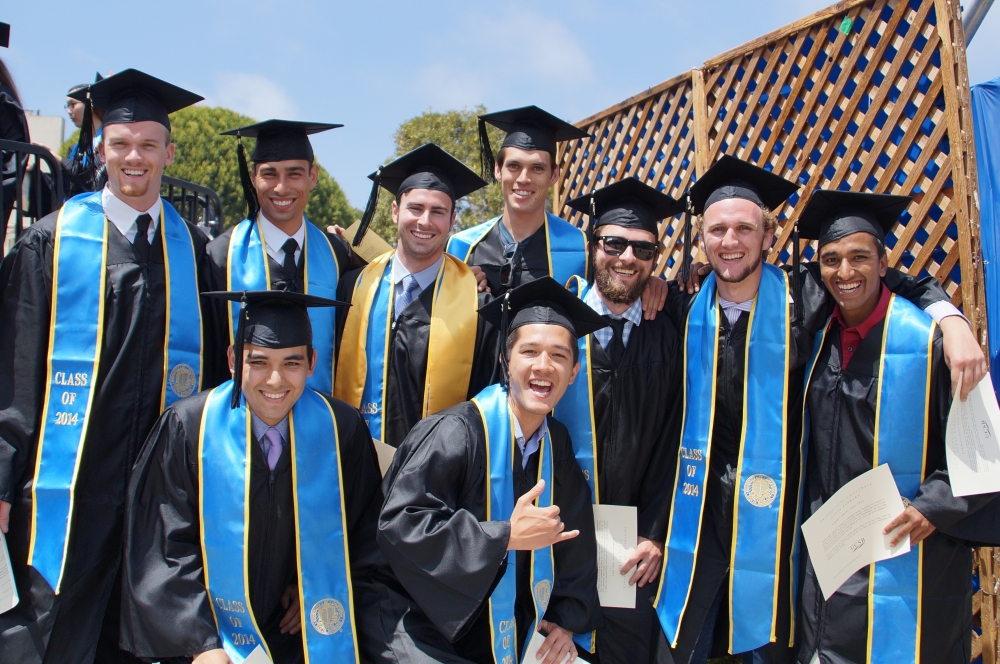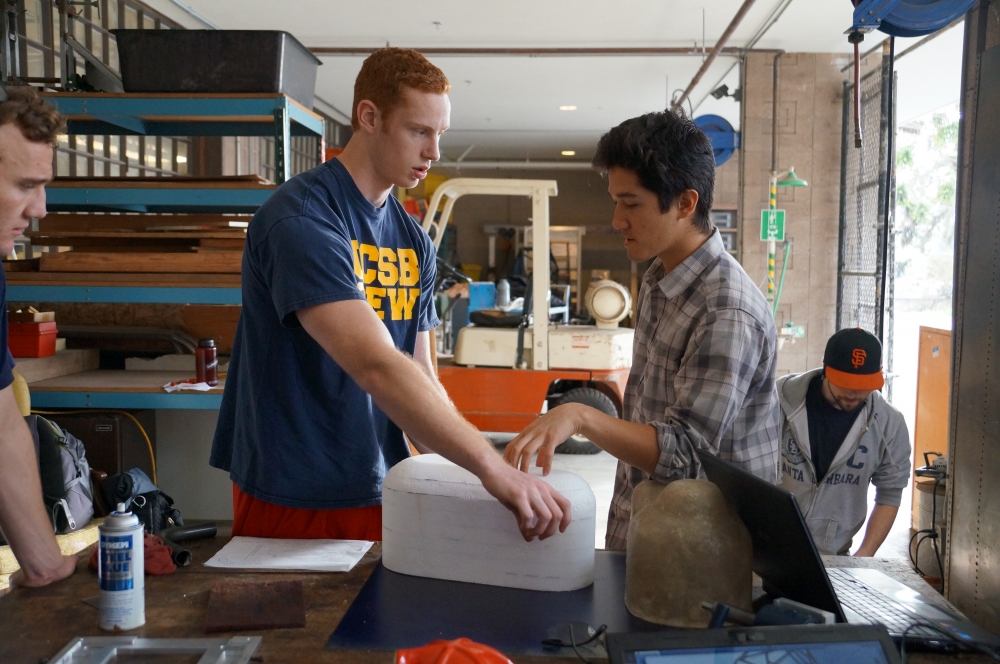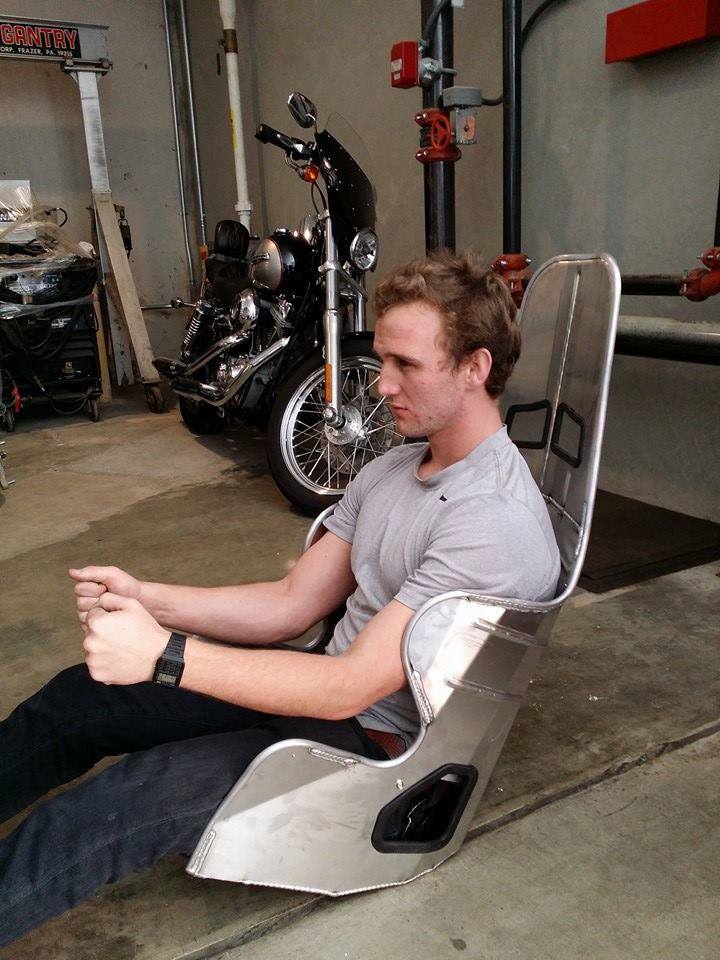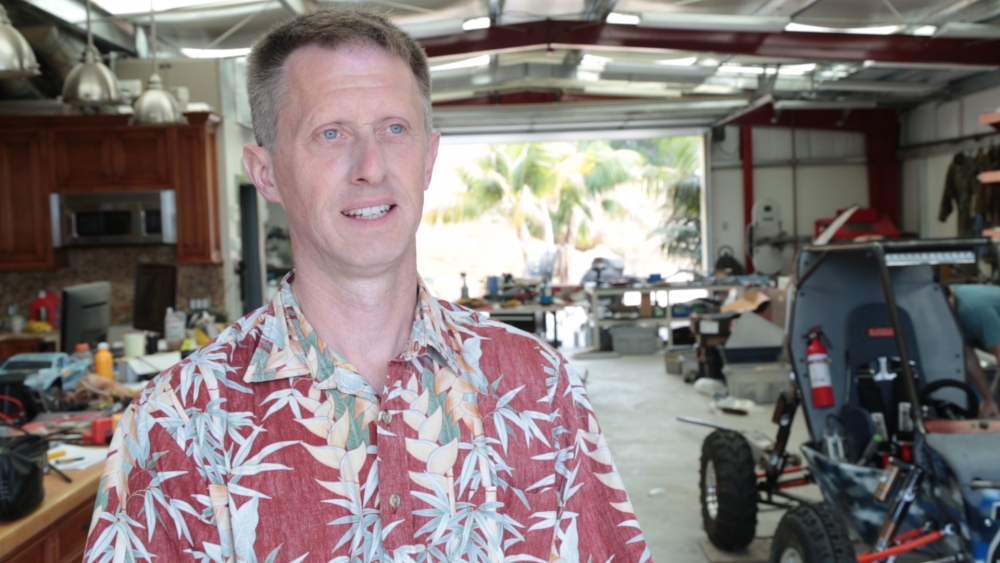Driven to Succeed





Last quarter, as thousands of UC Santa Barbara graduating seniors were digging in for the final exams of the school year, writing their last papers or, alternatively, wringing the most out of their senior year before moving on to higher degrees or the “real world,” a handful of UCSB engineering students headed down a home stretch of another kind: the 2014 Mini Baja race in Peoria, Illinois.
The objective? To build a one-person off-road car that can drive fast, maneuver over and around obstacles and endure extended run time on inhospitable terrain in one of the most popular intercollegiate design competitions in the world.
“We just like to build things with our hands,” said Tucker Root, one of 10 mechanical engineering seniors split across two teams for the project that also happened to be their senior capstone project. “We wanted to build something that we could actually use.”
Dividing their time among classes, fabrication, testing and little else, the students met alternately at the UCSB Engineering fabrication shop on campus and in a well-appointed garage they call “The Barn” in a quiet neighborhood near the university. Over the past year, they designed and built their vehicle, a deceptively simple machine that involves only the most necessary of equipment surrounding the regulation 10-horsepower Briggs & Stratton motor that all the participants in the race are required to use.
The Idea
“The Mini Baja is a national endeavor for universities that has existed for a long time,” said Glenn Beltz, associate dean of UCSB’s College of Engineering, professor of mechanical engineering and the adviser to Team 24, as the students are collectively known. Like the Mexican desert race that inspired this racing series, the Society of Automotive Engineers’ (SAE) Mini Baja races are a test of the limits of performance, endurance and handling of the vehicle. Unlike the Mexican desert race, however, the Mini Baja takes place on a controlled course, with scoring based on the ability of each car to overcome specific obstacles or run long distances without breaking down. Teams can choose one course or another and in doing so customize their designs to the requirements of the course. But to win, a team has to compete in all the events. So, for Team 24, it’s been a constant negotiation of durability and speed and maneuverability.
“Well, we only have to really last those few days,” a team member pointed out in one discussion. If they built a lighter car, they could be more competitive in the speed events but they would also increase the chance of breaking the very machine they would spend a year of their lives building. It was a risk worth taking.
“The goal for this capstone design course in general is for all students, no matter what project, to get good experience,” said Beltz, “and not only with fundamental design but also with building, testing, benchmarking and setting goals and meeting them.” His job, he said, is part cheerleading, part motivational intervention, part focusing and refocusing the students as well as guiding them through the required interviews. The Mini Baja simulates real-world challenges developing a market-worthy vehicle, from design to build to test, going beyond the pure engineering aspect of the race to its more entrepreneurial facets, such as fundraising and promotion.
Team 24 is not the first group of UCSB students to run in the Mini Baja races. But participation has been spotty at best, with teams forming maybe every other year. Would-be racers might have had other engineering interests, maybe the distance from home was a factor, or perhaps the non-engineering part of the Mini Baja — fundraising and promotion — was more than anyone wanted to do.
Because no one ever really thought to document and record their progress — another layer of work on top of everything else — each team, including 24, has essentially started from scratch.
And the competition is fierce, with teams from other engineering schools starting their competitors as early as their freshman years. Some show up in 18-wheelers with logos emblazoned on the sides.
But even for Beltz, who has overseen several other teams from UCSB, this group was different. They started early, planning each phase of the project from fundraising to the build schedule.
“They have been very organized, very focused on fundraising, very focused on what they need to do, not only in terms of academics but in terms of what they need to do to do well in terms of the competition. They have been, for me as an adviser, the ideal team,” he said. Part of the reason for this disciplined effort, he believes, is the large percentage of transfer students who bring with them some measure of real-world experience and developed time-management skills.
Still, it wasn’t easy. It takes money to race at Mini Baja — money to purchase the engine, money to purchase parts and equipment and extra parts and equipment, money to drive the 2,000 miles to Illinois and stay there for a couple of nights … money the group didn’t have, even after pounding the pavement all last summer and raising a few thousand dollars from local businesses, friends and family.
Fortunately for Team 24, there was Virgil Elings — UCSB physics professor, entrepreneur and philanthropist. His matching donation put the team just over the $15,000 it needed to get competitive.
“He’s legendary around town for being very interested in automotive projects — cars, motorcycles,” said Beltz. “He’s always been a very passionate advocate for hands-on training in terms of curriculum and I think he really has a point.”
The team has also embarked on a very detailed documentation of its progress, something to pass on to successive Mini Baja racers. Through photos and notes on their Facebook page and their website, team members have preserved step-by-step notes on their work in an effort to give the next group a head start.
Ultimately, according to the team, in addition to funding its expenses, the group wanted to establish a program to support future UCSB Mini Baja participants.
The Build
At the end of the day, it’s about the car, which at three-quarters the size and weight of previous models was the smallest to come out of the UCSB teams, at least in recent history. Elegance — the hallmark of a well-built machine — is apparent in the details: the adjustable steering wheel; the special-engineered cutting brake system for maneuverability; the cheese holing of solid metal parts to drop every ounce of weight without sacrificing strength; even the custom-built uprights that optimize the car to the terrain. While the capstone projects that they worked on concern only certain parts of the car, the team was bent on finishing every event and acing the engineering design and review — conducted by Society of Automotive Engineers officials — with the help of their adviser, who specializes in fracture mechanics.
The beauty of the Mini Baja for the participants is that it’s realistic — anything can change at any moment. The scary thing is that it’s realistic — anything can change at any moment, even during the race. So the run-up to the competition was an endurance race in itself as 24 tweaked its design and dealt with little surprises, or constantly analyzed its method to see if there was a better way to do things.
Over time, team members found their own niche. Tim Phillips has an affinity for composite materials, so he happily tackled the task of building parts of body panels. Ahdi Melkote is a natural teacher, so the visiting students interested in becoming next year’s competitors gravitated to him for guidance and inside knowledge. Dean Wink is particularly handy with machining parts and welding, so he played a large role in the assembly of the chassis, while Spencer Wass and Kyle Wollert took on the suspension.
After the building came the breaking in of the car, as the team put it to the test, pitting it against rocks, logs and jumps. This was, arguably, the most fun part of the build.
“We’ve all been working so hard on this thing and it’s designed such that if it fails, it’ll fail because of the design, and not because of us,” said Root.
And then there was the road trip: three days of hauling car, parts, equipment and people from the West Coast to the Midwest — perhaps the true test of this team’s cohesiveness.
The Race
A year’s worth of late nights and coffee-fueled days, missed social appointments and more trials and errors than the team could count came to a head on June 4, with 24 arriving at the dusty, rocky and obstacle-ridden track in Peoria.
“Illinois is beautiful,” the teammates wrote on their Facebook page. But it’s also the Midwest, birthplace of the American automotive industry, and thus also home to some of the nation’s top mechanical engineering schools. Contestants in this race are veteran car builders, with years, perhaps even generations of Mini Baja knowledge behind them. Added to that are competitors from elsewhere around the world with exceptional mechanical engineering schools.
Simply to make it to the race, and be counted among the likes of the University of Michigan, the University of Wisconsin or Cornell, is no small feat for the UCSB racers. And to participate and finish in every heat is rarer still, as previous UCSB teams have tended to focus on one aspect of the race or another, without the full spectrum of competition in mind.
And while competition is intense, the group noted, it’s not cutthroat. Teams share information and ideas freely, something 24 came to rely on in the absence of previous years’ documentation. Even during the races, teams lend one another what they can to get through the race: a part they can spare, a tool, even some advice.
Team 24’s performance was more than just respectable; it was impressive against the big guns of the mechanical engineering schools in the world and against a field of more than a hundred competitors. They placed 64th in hill climb, 36th in acceleration and 16th in rock crawl. Team member Terry Davis took the team to ninth overall in the maneuverability test, a hectic series of twists, turns, elevation changes and bumps in the road. Off the track, they scored significant marks in the cost report and cost prototype evaluations as well as their sales presentation.
The Finish Line
For all the work and excitement, the competition itself was the very intense, very fun icing on the cake. The team that started out ambitious and just a little cocky a year ago is now a team that knows its capabilities and how to push beyond limitations. The team that started out with virtually nothing now leaves its own legacy and a head start for the next Baja team, which already has members. The group that started out relying on what it has come to call “Old-Man Knowledge” — advice from veterans that doesn’t make sense at first but comes into play in a major way down the line — can dispense some of its own. And it is this rite of passage — seeing an idea from amorphous concept to concrete completion — that these teammates bring with them as they go into industry, as some have already done, or to grad school, as some are planning to do. There’s all that, plus some bragging rights and lots of good memories.
“It’s going to be weird saying goodbye to all of this,” Root said. “But it’s going to be a fun road.”



